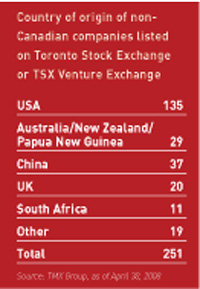Since limits on foreign investment were lifted, Canada has become the latest roadshow stop
In March 2005 the floodgates to a multi-billion-dollar pool of capital suddenly and unexpectedly burst open. That’s when the Canadian government eliminated the 30 percent cap on foreign investments by registered pension and other deferred income plans. Since then, Canadian institutions have steadily ramped up their international equity holdings. A Greenwich Associates study reveals that overseas allocations jumped from 51 percent of total equity portfolios in 2004 to 58 percent last year.
The foreign surge seems far from cresting, according to study author Rodger Smith, a managing director at Greenwich Associates. ‘Canadians have come a long way, but it looks like they will go further,’ he says. ‘Canada represents about 3 percent of the MSCI World index, and by that benchmark foreign exposure is still under-represented.’
Of course, all this new money looking for a foreign home has not escaped the attention of globe-trotting IROs – but is Canada now a hot new stop on their roadshow tours? As Smith points out, a significant portion of Canadian assets is still managed offshore. Despite that caution, however, Canada is beckoning like never before, and many investor relations professionals are answering the call.
Sophie Jolly, head of IR at Finnish elevator and escalator company Kone, is one of them. She is planning a visit this fall. ‘We’ve never been to Canada before, but all my research suggests there’s a lot of potential there,’ she says. ‘As we say in Finland, we’ll knock on the ice to see if it can carry our weight.’
Cream of the crop
A major attraction for Jolly is the promise of catching the attention of high-quality, long-term investors. ‘Our business is a long-term one and, especially with today’s volatile market, it would suit our ownership structure to have matching investors,’ she says. ‘Canada is a place where we expect to find them.’
That seems to have been the experience for Peter Wullschleger, head of investor and media relations at Swiss-based flavor and fragrance giant Givaudan. He’s been traveling to Canada for seven years, and Toronto-based shareholders presently own more than 3 percent of the company.
‘The Canadian style is somewhat different from that of New York,’ comments Wullschleger. ‘In my experience, Canadians are generally much more drawn to fundamentals and a long-term orientation. If you are visiting the east coast of North America looking for value-driven investors, Toronto is a must-visit. There’s a lot of interest up there that sometimes gets overlooked.’
That sentiment is echoed by Frank Boer, New York-based vice president of sales at Chevreux, Crédit Agricole’s brokerage arm. ‘Our clients have definitely noticed that more money is available since the restrictions have been lifted,’ he says. ‘It’s been very visible.’ On top of a penchant for the long haul, Boer points out a number of additional Canadian charms: ‘The Canadian fund management industry has seen considerable consolidation, which makes one-on-ones a lot more effective. And, because it is relatively rare for Canadians to see companies, they tend to come to each meeting very well prepared.’
Kevin Kusterer, a sales associate at New York-based small-cap equity research provider Sidoti & Co, agrees. ‘Canadians aren’t overwhelmed with meetings and always seem prepared and ready to go,’ he points out. ‘Some people don’t expect the expertise or money to be there – but it is. Canada is definitely worth the trip.’
Cold cash
An important driver of Canadian capital may be the desire to diversify away from domestic resources. ‘For years you could almost throw a dart at resource companies and make money,’ says Kusterer. ‘Nowadays a lot of people have a lot of money as a result of the resource boom, and they want to diversify to the US and away from Canada.’
How deep and robust that desire really is remains to be seen. ‘It is curious that Canadian pension funds would continue to significantly underweight US stocks,’ says Rick Hanley, managing partner at New York-based Hanley & Associates, which conducts non-deal roadshows.
‘They are now free to invest as much as they want, and the MSCI index would suggest a benchmark weighting in US stocks of over 50 percent on any given day. The actual day-to-day exposure of Canadian managers toward US companies and the economy does not appear to have approached this benchmark weighting, however. When you factor in the economic growth, interest rate and inflation outlook and impact on factors like currencies, investors appear to view other markets around the world as being more attractive than the US.’
Hanley is pragmatic when it comes to US-based companies’ Canadian IR efforts. He points to a survey conducted recently by his firm showing the average US-based issuer spent only 11 days marketing C-level executives globally during non-deal roadshows in 2007. Only 22 percent of survey respondents had conducted non-deal roadshows in Canada, an amount similar to the number of companies that visited investors in less well-traveled US markets such as Ohio and Michigan during the same year.
‘With so little C-suite time to dedicate to meeting investors through roadshows, I think each company must evaluate the depth of its relationships with US-based investors before going abroad and facing the cultural and currency differences, governance standards and other challenges that come with marketing a story internationally,’ says Hanley.
Must-have listing
If US companies in general don’t glow prominently on Canadian radar screens, US junior mining firms aren’t even smudges on the glass, unless sprinkled with the fairy dust of a Canadian listing. ‘Canadian institutions – and European ones as well – loathe companies listed on the Over-The-Counter Bulletin Board [OTCBB],’ states Kelly Boatright, chairman and CEO of resource sector IR and PR specialist Windward Global. ‘They see that market as poorly regulated and just won’t touch its stocks. Even getting an audience for Amex companies is difficult unless they have a dual listing in Toronto.’
The hostility toward OTCBB companies is so intense that even Boatright won’t touch them. ‘It’s a nightmare,’ he laments. ‘When they call looking to hire us, we say, Good luck, and call us when you get on a Canadian exchange. Then you’ll be respected by fund managers not only in Canada but in Europe as well.’
One of the key managers many IROs make a point of trying to see while in Canada is Wayne Kozun, head of equities at Ontario Teachers’ Pension Plan, Canada’s third-largest pension fund. He confirms that significantly more corporate roadshows, particularly European ones, are making stops in Toronto than were doing so three years ago. A strong magnet, he says, is the fact that many of the largest Canadian pensions do much more investing in-house then their US or UK counterparts.
‘Besides using fewer external managers, more and more funds are giving their internal managers a global mandate,’ explains Kozun, who oversees about C$35 bn ($34.5 bn) worth of stock. ‘With a global benchmark, they are as likely to own a Canadian stock as, for example, a South American one.’
Kozun adds that he’s seeing a fair amount of opportunity in Brazil. ‘Three or four years ago, it would have been unlikely for Canadian institutions to pay much attention to South America,’ he says. ‘That’s definitely not the case today.’
Ultimately, while it might not be at the top of everyone’s to-do list, an exploratory expedition into the Great White North can certainly be a worthwhile endeavor. As Wullschleger concludes: ‘My suggestion is to go to Montreal and Toronto – and keep going. It’s rewarding.’
Home from home
By Neil Stewart
Investors and analysts like what they know. In Canada, that’s oil, gas and mining. Companies in those sectors, wherever they might be based, are finding a wealth of smart investment pros in Canada. A growing number are also discovering a stock exchange that is already packed with similar issuers.
Take mining, for example. Last year Toronto was home to $17.6 bn in mining financings, compared with $9.9 bn on the London Stock Exchange and AIM. Nearly 1,400 mining companies out of a total of 3,800 are listed on Toronto Stock Exchange (TSX) and TSX Venture Exchange (TSXV). TMX Group, the entity created when Toronto’s junior and senior stock exchanges merged with Montreal exchange recently, says it has 57 percent of the world’s public mining companies. Now it wants more.
Over the last two years, TMX Group has taken a hard look at the increasingly global fight for listings. ‘We wanted to break through that noise,’ says Kevan Cowan, president of TSXV. ‘We felt our main strengths were mining, oil and gas, and small and medium-sized enterprises [SMEs]. Then we looked at the world map and identified where those strengths play.’
Canada is already the top foreign listing destination for US companies, and TMX Group wants to keep those listings coming. The exchange has met with success in Australia and South Africa, and is now setting its sights on South America. Israel and Russia are also possibilities. As for China, SMEs from there that may consider listing in Toronto ‘cut across all sectors,’ Cowan says. Seven Chinese companies listed in Toronto in 2007, and one exchange official has said he expects 25 to 40 a year within five years. In May TMX Group went on a Chinese roadshow to help attract listings. Its entourage included three Canadian investment banks, three law firms and three accounting firms.
As for China, SMEs from there that may consider listing in Toronto ‘cut across all sectors,’ Cowan says. Seven Chinese companies listed in Toronto in 2007, and one exchange official has said he expects 25 to 40 a year within five years. In May TMX Group went on a Chinese roadshow to help attract listings. Its entourage included three Canadian investment banks, three law firms and three accounting firms.
Cowan boasts of how TSXV has produced more than 400 ‘graduates’ that have moved on to TSX’s senior equity market. ‘We’re one of the few businesses that is happy to lose its customers,’ he jokes.










